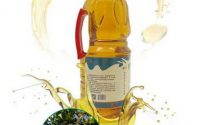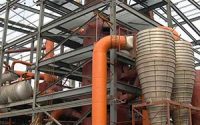Soybean Oil Production Line Overview
The soybean oil production line is the process of treating soya bean with the press method or leaching method to obtain more crude oil and then refined to obtain edible refined oil. Pressed soybean oil has natural colors, aromas and flavors, and retains raw material’s various nutritious ingredients when comparing with the leached oil. The physical pressing line requires raw materials to be carefully selected, and the soya bean is pre-treated through cleaning, crushing, softening, rolling and extruding. After that, the cleaned beans are added during the pressing process and the oil is extracted from the pressing machine, and the finished oil is produced by using high-tech physical refining filtration purification technology. The physical pressing method maintains the original flavor of soybeans, rich in vitamin E, and has a long shelf life. And the screw pressed oil has no additives, no solvent residue, and no soap content. Soybean oil pressing line is a combination of modern and traditional technology that produces pure natural soybean oil.
Main Sections of Completed Soybean Oil Production Line
Before the oil is prepared, the pretreatment of soybeans requires cleaning, crushing, softening, rolling, extruding, etc. for the soybean oil processing industry.
1.1 Soybean Cleaning
Soybean should be cleaned first. The main purpose of this section is to remove the impurities of soybeans. The impurities are mainly plant impurities (such as bean stems, pods, etc.), metal impurities and non-metallic impurities.
1.1.1 Main equipment
- Magnetic separator: adopts magnetic force to remove metal impurities by using the magnetic difference of various ores or materials, the metal impurities are usually nails, small iron wire, etc. Removal of metal impurities avoids the abrasion on the machine in the subsequent work.
- Vibrating cleaning screen: The raw material may contain soil, leaves, stems and other ball impurities, which need to be cleaned up before the subsequent process. High-frequency vibration equipment can effectively remove impurities by using differences between oil and impurities in particle size, with the help of the relative movement between impure oilseed and sieve surface, finally, the impurities larger than or less than oilseed can be removed through the sieve hole. This kind of cleaning sieve is suitable for medium and large factories.
1.2 Soybean Crushing
After cleaning, the soybeans are sent to the crushing section, the main purpose is to crush the soybeans and separate the soybean skins from the bean kernels.
1.2.1 Toothed roll crusher
Generally, soybeans are required to be broken into 4 to 8 valves, and the powdery degree (when crushed beans passing through 20 meshes screen) is less than 10%. The crusher is preferably a toothed roll crusher with cutting, impacting and bending effects. Toothed roll crusher is mainly used for crushing such large granular material like soybeans, so as to produce the excellent embryo and improve the yield. The machine has the characteristics of small noise, high output, uniform crushing granularity, low power consumption, small footprint, simple structure, flexible and reliable, convenient maintenance and so on.
1.2.2 Purposes of crusher
- Crushing makes the oil material with a certain granularity to facilitate compact rolling.
- Crushing increases the surface area of the oilseed, which is conducive to the transfer of temperature and moisture in the softening process of the oilseed and ensure the softening effect.
- The seeds are crushed into small granules, which is good for the next oil press section.
1.3 Soybean Softening
Softening is through the adjustment of oilseed moisture and temperature to improve the elasticity of seed so that it has the best conditions for rolling. Softening is mainly used for seeds with low oil content, low water content, poor physical properties and hard texture. Soybeans have low oil content and poor plasticity, which need to be softened before rolling. Softening temperature should be based on the level of soybean moisture. When soybean moisture is 13%~15%, the softening temperature is usually controlled at 70~80℃, and the softening time is 15~30 minutes. The commonly used softener for soybeans is a horizontal softening pot, which has a better softening effect.
1.3.1 The main function of softening
- It gives the soybean kernel certain plasticity and makes it easy to roll out the thin flakes when flaking.
- Softening can reduce the powder degree and sticky roller phenomenon, to ensure the quality of the flakes.
1.3.2 Working principle of horizontal softener
The material enters the drum through the inlet, and with the rotation of the drum, the material is constantly turned over. Meanwhile, the drum is equipped with a heating tube and steam is passed through the tube, the material is heated, steamed and rotated at the same time. According to the softening condition of the material, the softening time of the material can be controlled by adjusting the rotating speed of the rotary drum to optimize the softening effect.
1.3.3 Features of horizontal softener
- The rotation of the horizontal softening pot makes the material turn over more evenly, and without dead angle. With the improvement of avoiding the dead angle of layer softening pot, which causes the phenomenon of burnt paste, the horizontal softener can soften the material evenly and thoroughly.
- The horizontal softener avoids the abrasion of the scraper and heating layer, so the equipment has long service life, low failure rate and low maintenance cost.
- Because of its unique structure, the volume of horizontal softening pot is much smaller than that of layer type, the arrangement of it in workshop is easier, the area of occupation is small, and the investment of equipment is greatly reduced.
1.4 Soybean Rolling
Soybean rolling is the process of using the mechanical function to roll the oilseed from the granular to flake.
1.4.1 Purpose of soybean rolling
The purpose of rolling is to destroy the cell structure of oilseed, increase the surface area of seed and shorten the distance of oil flowing out, which is beneficial to the extraction of oil. In order to ensure the quality of rolled flakes, the moisture and temperature of materials before rolling should be strictly controlled.
1.4.2 Soybean rolling equipment structure
- Feeding mechanism: keep flowing and distributing uniformly
- Roller: main working part
- Distance adjusting device: spring type, lever type, hydraulic type
- Baffle and scraper
- Transmission device
1.5 Soybean Extruding
Soybean extruding is the process of using extrusion equipment to break through the crushed, rolled soybean into porous, expanded granular material. Extrusion is a kind of high temperature and short time processing. At present, the commonly used soybean extruding machine is low moisture single-screw extruder, and the material is extruded by heating, pressing, gluing and vacuum extrusion. Generally, extrusion temperature can reach 110~200℃, and the residence time in the extruder is for the l~3 minutes.
Soybean Oil Application
1. In Food Industry
Liquid soybean oil is sold as “vegetable oil” or as a component of processed food like margarine, shortening, mayonnaise and various flavoring oils. The refined soybean oil is pale yellow, clear, transparent, odorless, and has a good taste. It can be used for cooking without foam and smoke. It is mainly used as cold salad oil in addition to as the cooking, frying oil. And the remaining soya bean cakes are used as animal feed.
2. In Chemical Industry
The Soya lecithin, one of the extracts from soybean oil sediments, can also be used in the chemical field. For example, the soya lecithin can be used as antioxidants, color enhancers, catalysts, emulsifiers, grinding aids, and viscosity modifiers in paints and inks. It can evenly disperse pigments, prevent sedimentation, stabilize water-based paints, impart luster to dry film, and improve the fluidity of printing inks; The addition of phospholipids to the paint shortens the kneading time during the manufacturing process and prevents pigment precipitation. And it can produce a good color, increase painting performance, so that the brushing surface is dry, smooth, soft and bright.



